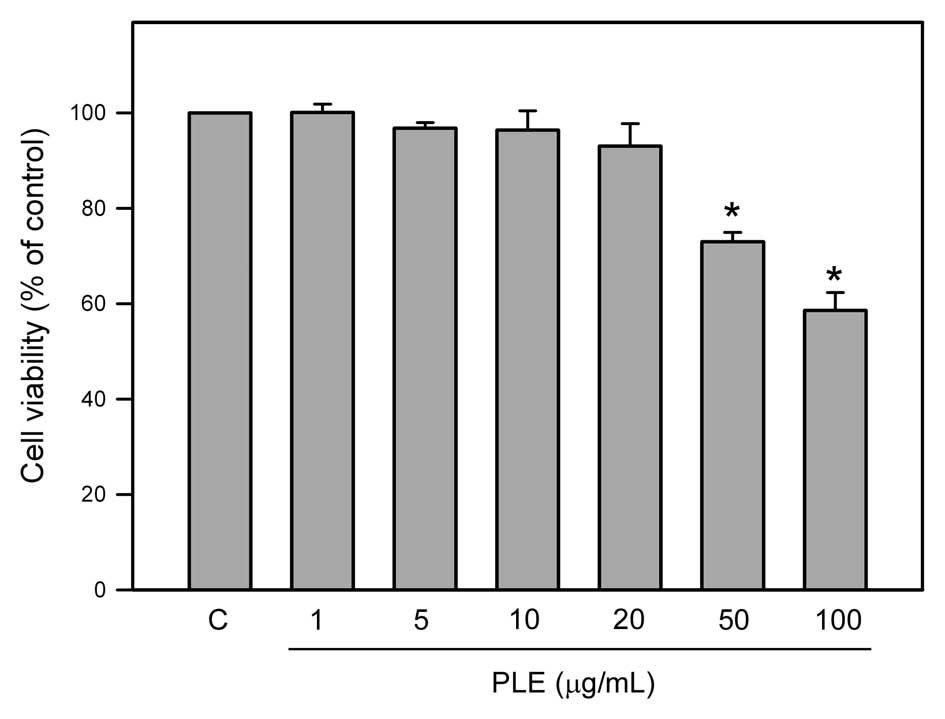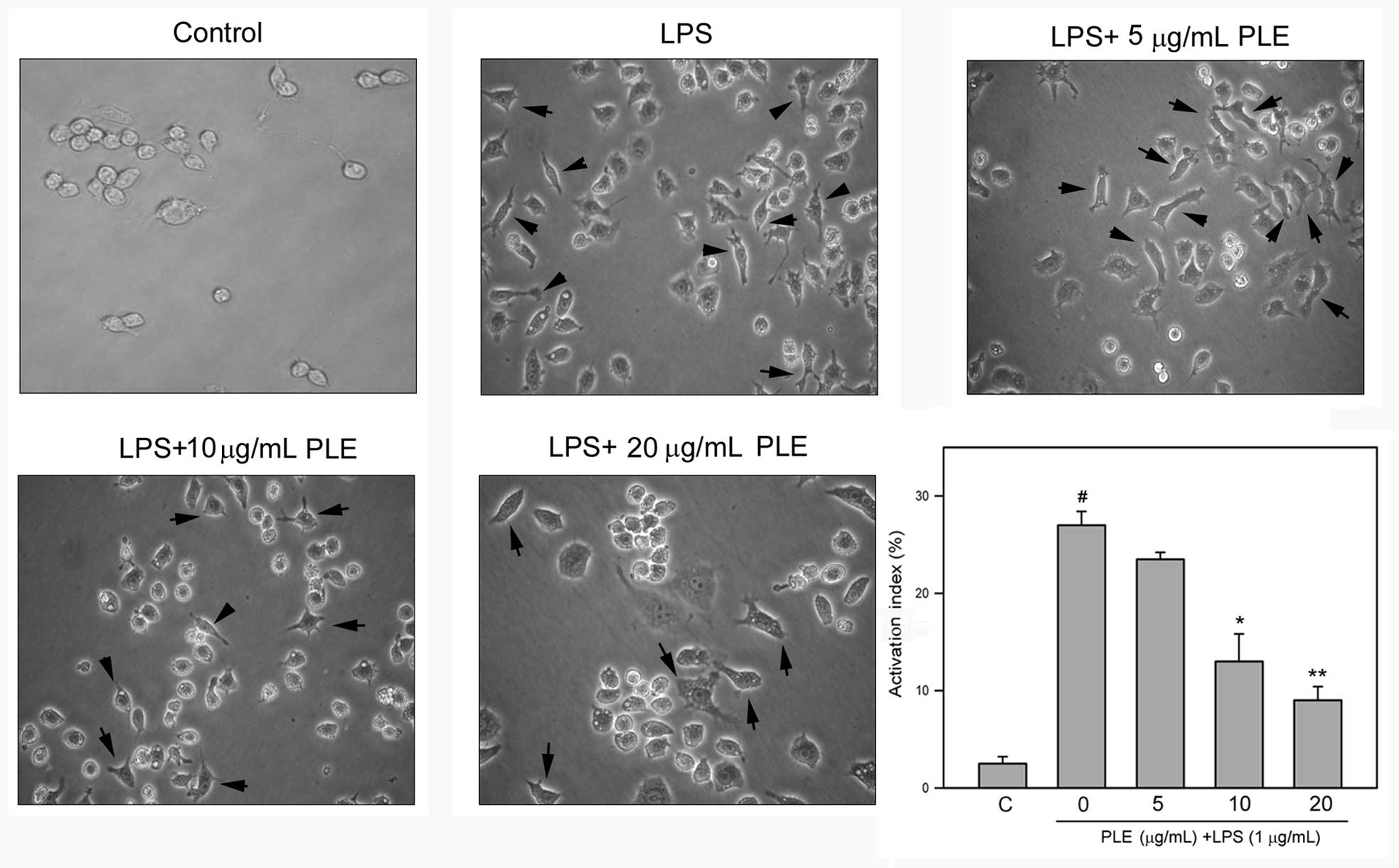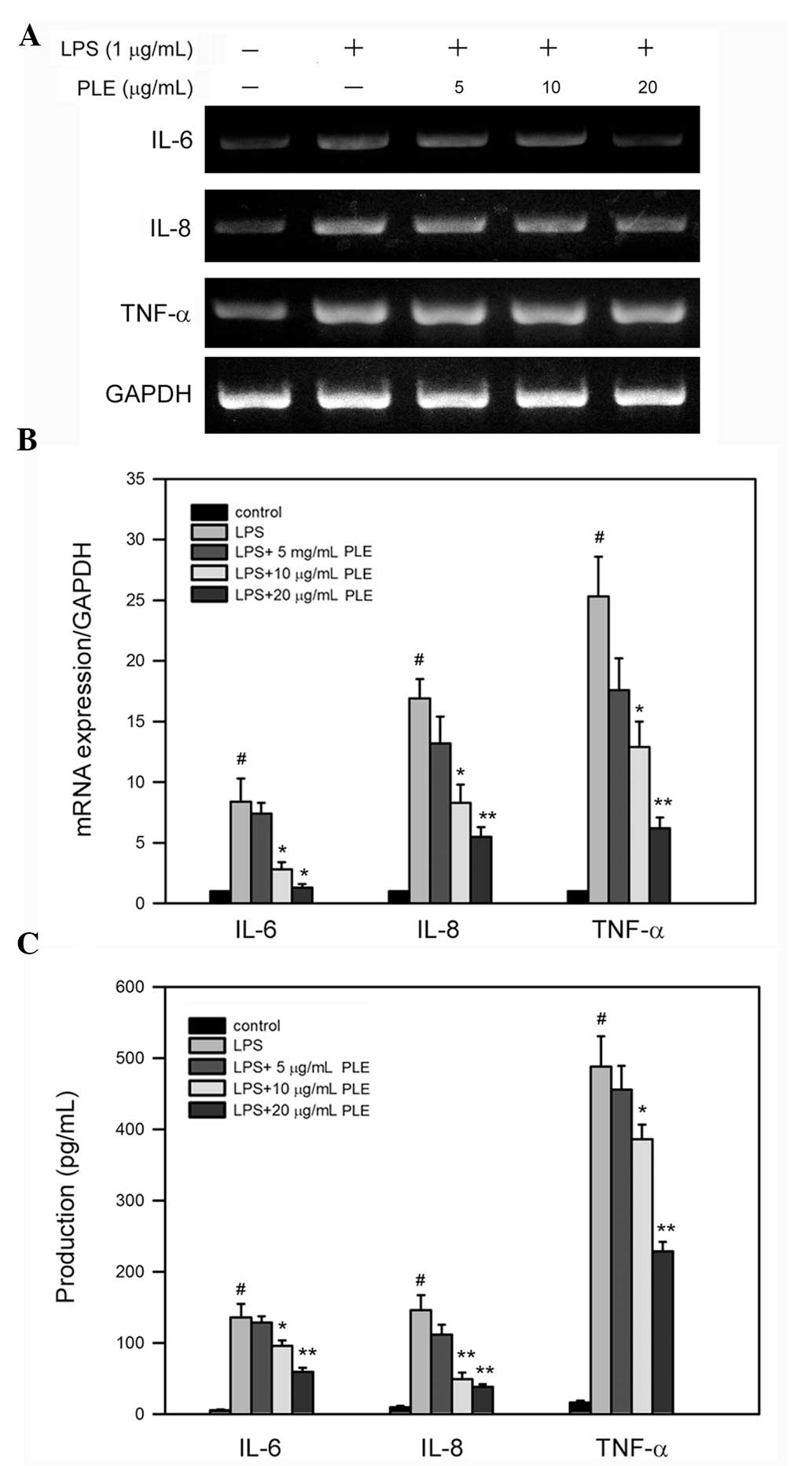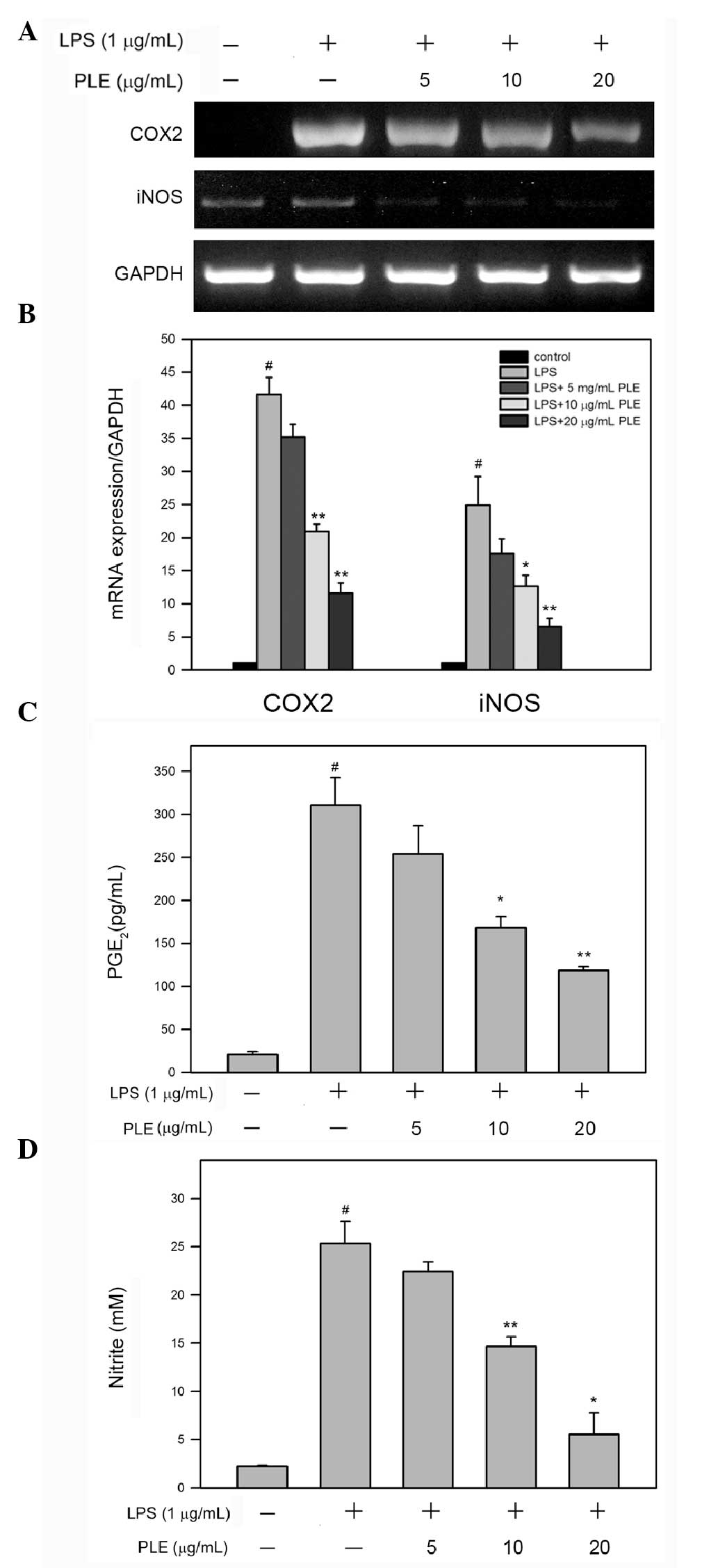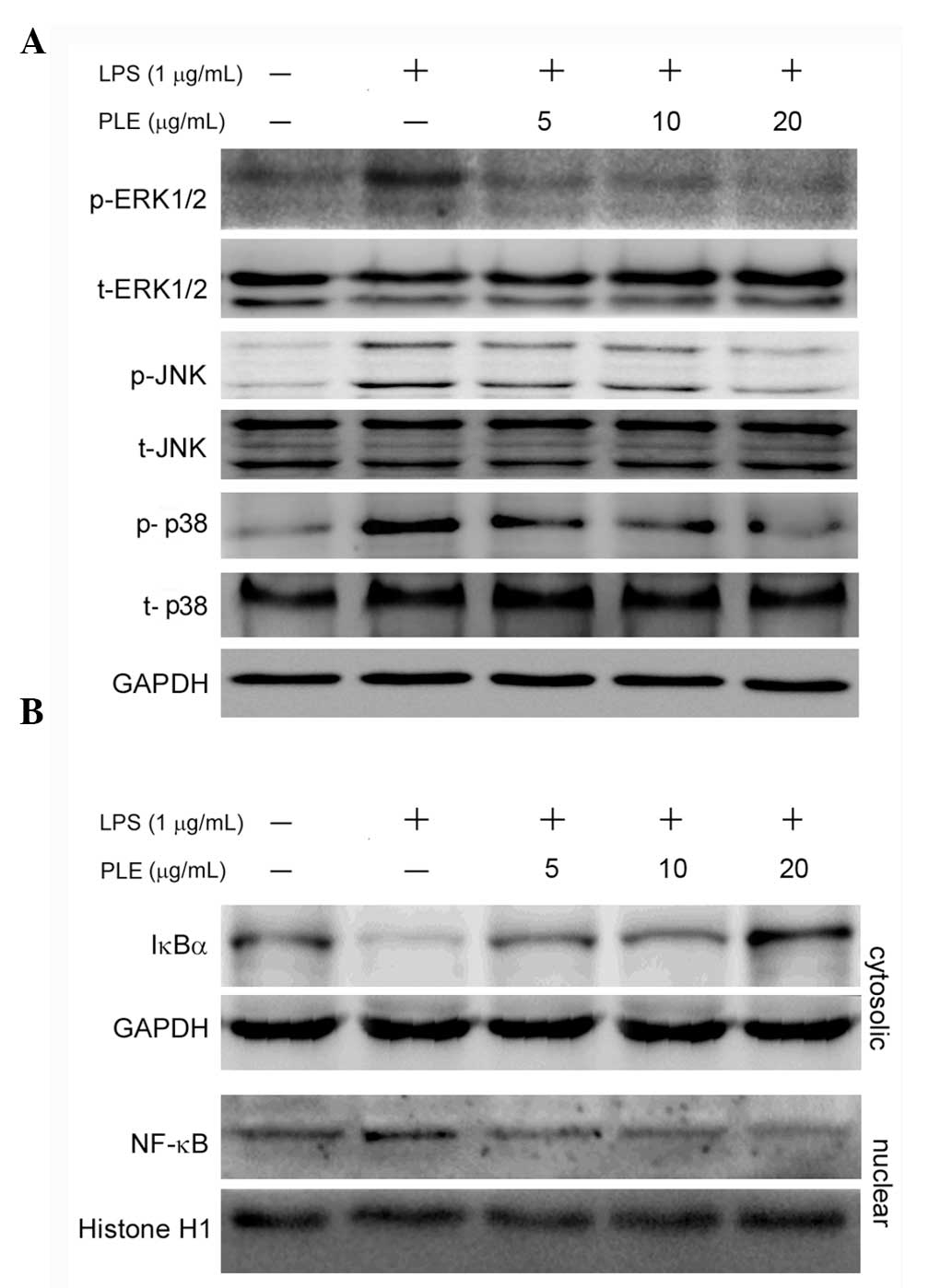|
1
|
Ueda H and Yamazaki M: Inhibition of tumor
necrosis factor-alpha production by orally administering a
Perilla leaf extract. Biosci Biotechnol Biochem.
61:1292–1295. 1997. View Article : Google Scholar : PubMed/NCBI
|
|
2
|
Makino T, Ono T, Muso E, Honda G and
Sasayama S: Suppressive effects of Perilla frutescens on
spontaneous IgA nephropathy in ddY mice. Nephron. 83:40–46.
1999.
|
|
3
|
Ueda H and Yamazaki M: Anti-inflammatory
and anti-allergic actions by oral administration of a
Perilla leaf extract in mice. Biosci Biotechnol Biochem.
65:1673–1675. 2001. View Article : Google Scholar : PubMed/NCBI
|
|
4
|
Shin TY, Kim SH, Kim SH, et al: Inhibitory
effect of mast cell-mediated immediate-type allergic reactions in
rats by Perilla frutescens. Immunopharmacol Immunotoxicol.
22:489–500. 2000. View Article : Google Scholar : PubMed/NCBI
|
|
5
|
Hortelano S, Zeini M and Bosca L: Nitric
oxide and resolution of inflammation. Methods Enzymol. 359:459–465.
2002. View Article : Google Scholar : PubMed/NCBI
|
|
6
|
Paige JS and Jaffrey SR: Pharmacologic
manipulation of nitric oxide signaling: targeting NOS dimerization
and protein-protein interactions. Curr Top Med Chem. 7:97–114.
2007. View Article : Google Scholar : PubMed/NCBI
|
|
7
|
Gao YT, Panda SP, Roman LJ, Martasek P,
Ishimura Y and Masters BS: Oxygen metabolism by neuronal
nitric-oxide synthase. J Biol Chem. 282:7921–7929. 2007. View Article : Google Scholar : PubMed/NCBI
|
|
8
|
Breitbach K, Klocke S, Tschernig T, van
Rooijen N, Baumann U and Steinmetz I: Role of inducible nitric
oxide synthase and NADPH oxidase in early control of
Burkholderia pseudomallei infection in mice. Infect Immun.
74:6300–6309. 2006. View Article : Google Scholar : PubMed/NCBI
|
|
9
|
Cunha IW, Lopes A, Falzoni R and Soares
FA: Sarcomas often express constitutive nitric oxide synthases
(NOS) but infrequently inducible NOS. Appl Immunohistochem Mol
Morphol. 14:404–410. 2006. View Article : Google Scholar : PubMed/NCBI
|
|
10
|
Farley KS, Wang LF, Razavi HM, et al:
Effects of macrophage inducible nitric oxide synthase in murine
septic lung injury. Am J Physiol Lung Cell Mol Physiol.
290:L1164–L1172. 2006. View Article : Google Scholar : PubMed/NCBI
|
|
11
|
Sacco RE, Waters WR, Rudolph KM and Drew
ML: Comparative nitric oxide production by LPS-stimulated
monocyte-derived macrophages from Ovis canadensis and Ovis aries.
Comp Immunol Microbiol Infect Dis. 29:1–11. 2006. View Article : Google Scholar : PubMed/NCBI
|
|
12
|
Rahman A, Yatsuzuka R, Jiang S, Ueda Y and
Kamei C: Involvement of cyclooxygenase-2 in allergic nasal
inflammation in rats. Int Immunopharmacol. 6:1736–1742. 2006.
View Article : Google Scholar : PubMed/NCBI
|
|
13
|
Geng Y, Zhang B and Lotz M: Protein
tyrosine kinase activation is required for lipopolysaccharide
induction of cytokines in human blood monocytes. J Immunol.
151:6692–6700. 1993.PubMed/NCBI
|
|
14
|
Kim HS, Ye SK, Cho IH, et al:
8-hydroxydeoxyguanosine suppresses NO production and COX-2 activity
via Rac1/STATs signaling in LPS-induced brain microglia. Free Radic
Biol Med. 41:1392–1403. 2006. View Article : Google Scholar : PubMed/NCBI
|
|
15
|
Park HJ, Kim IT, Won JH, et al:
Anti-inflammatory activities of
ent-16alphaH,17-hydroxy-kauran-19-oic acid isolated from the roots
of Siegesbeckia pubescens are due to the inhibition of iNOS
and COX-2 expression in RAW 264.7 macrophages via NF-kappaB
inactivation. Eur J Pharmacol. 558:185–193. 2007. View Article : Google Scholar : PubMed/NCBI
|
|
16
|
Nakano H, Shindo M, Sakon S, et al:
Differential regulation of IkappaB kinase alpha and beta by two
upstream kinases, NF-kappaB-inducing kinase and mitogen-activated
protein kinase/ERK kinase kinase-1. Proc Natl Acad Sci USA.
95:3537–3542. 1998. View Article : Google Scholar
|
|
17
|
Green LC, Wagner DA, Glogowski J, Skipper
PL, Wishnok JS and Tannenbaum SR: Analysis of nitrate, nitrite, and
[15N]nitrate in biological fluids. Anal Biochem. 126:131–138.
1982.
|
|
18
|
Saxena RK, Vallyathan V and Lewis DM:
Evidence for lipopolysaccharide-induced differentiation of RAW264.7
murine macrophage cell line into dendritic like cells. J Biosci.
28:129–134. 2003. View Article : Google Scholar : PubMed/NCBI
|
|
19
|
Onuchic AC, Machado CM, Saito RF, Rios FJ,
Jancar S and Chammas R: Expression of PAFR as part of a prosurvival
response to chemotherapy: a novel target for combination therapy in
melanoma. Mediators Inflamm. 2012:1754082012. View Article : Google Scholar : PubMed/NCBI
|
|
20
|
Chen H, Ma F, Hu X, Jin T, Xiong C and
Teng X: Elevated COX2 expression and PGE2 production by
downregulation of RXRα in senescent macrophages. Biochem Biophys
Res Commun. 440:157–162. 2013.PubMed/NCBI
|
|
21
|
Adesso S, Popolo A, Bianco G, et al: The
uremic toxin indoxyl sulphate enhances macrophage response to LPS.
PloS One. 8:e767782013. View Article : Google Scholar : PubMed/NCBI
|
|
22
|
Hambleton J, Weinstein SL, Lem L and
DeFranco AL: Activation of c-Jun N-terminal kinase in bacterial
lipopolysaccharide-stimulated macrophages. Proc Natl Acad Sci USA.
93:2774–2778. 1996. View Article : Google Scholar : PubMed/NCBI
|
|
23
|
An H, Yu Y, Zhang M, et al: Involvement of
ERK, p38 and NF-kappaB signal transduction in regulation of TLR2,
TLR4 and TLR9 gene expression induced by lipopolysaccharide in
mouse dendritic cells. Immunology. 106:38–45. 2002. View Article : Google Scholar : PubMed/NCBI
|
|
24
|
Wang W, Deng M, Liu X, Ai W, Tang Q and Hu
J: TLR4 activation induces nontolerant inflammatory response in
endothelial cells. Inflammation. 34:509–518. 2011. View Article : Google Scholar : PubMed/NCBI
|
|
25
|
Tak PP and Firestein GS: NF-kappaB: a key
role in inflammatory diseases. J Clin Invest. 107:7–11. 2001.
View Article : Google Scholar : PubMed/NCBI
|
|
26
|
Murakami A, Nishizawa T, Egawa K, et al:
New class of linoleic acid metabolites biosynthesized by corn and
rice lipoxygenases: suppression of proinflammatory mediator
expression via attenuation of MAPK- and Akt-, but not PPARgamma-,
dependent pathways in stimulated macrophages. Biochem Pharmacol.
70:1330–1342. 2005. View Article : Google Scholar
|
|
27
|
Fujiwara N and Kobayashi K: Macrophages in
inflammation. Curr Drug Targets Inflamm Allergy. 4:281–286. 2005.
View Article : Google Scholar
|
|
28
|
Heumann D and Roger T: Initial responses
to endotoxins and Gram-negative bacteria. Clin Chim Acta.
323:59–72. 2002. View Article : Google Scholar : PubMed/NCBI
|
|
29
|
Desai TR, Leeper NJ, Hynes KL and Gewertz
BL: Interleukin-6 causes endothelial barrier dysfunction via the
protein kinase C pathway. J Surg Res. 104:118–123. 2002. View Article : Google Scholar : PubMed/NCBI
|
|
30
|
Noda A, Kinoshita K, Sakurai A, Matsumoto
T, Mugishima H and Tanjoh K: Hyperglycemia and lipopolysaccharide
decrease depression effect of interleukin 8 production by
hypothermia: an experimental study with endothelial cells.
Intensive Care Med. 34:109–115. 2008. View Article : Google Scholar : PubMed/NCBI
|
|
31
|
Hume DA, Underhill DM, Sweet MJ, Ozinsky
AO, Liew FY and Aderem A: Macrophages exposed continuously to
lipopolysaccharide and other agonists that act via toll-like
receptors exhibit a sustained and additive activation state. BMC
Immunol. 2:112001. View Article : Google Scholar
|
|
32
|
Aggarwal BB, Shishodia S, Ashikawa K and
Bharti AC: The role of TNF and its family members in inflammation
and cancer: lessons from gene deletion. Curr Drug Targets Inflamm
Allergy. 1:327–341. 2002. View Article : Google Scholar : PubMed/NCBI
|
|
33
|
Tsatsanis C, Androulidaki A, Venihaki M
and Margioris AN: Signalling networks regulating cyclooxygenase-2.
Int J Biochem Cell Biol. 38:1654–1661. 2006. View Article : Google Scholar : PubMed/NCBI
|
|
34
|
Aggarwal BB, Shishodia S, Sandur SK,
Pandey MK and Sethi G: Inflammation and cancer: how hot is the
link? Biochem Pharmacol. 72:1605–1621. 2006. View Article : Google Scholar : PubMed/NCBI
|
|
35
|
Korhonen R, Lahti A, Kankaanranta H and
Moilanen E: Nitric oxide production and signaling in inflammation.
Curr Drug Targets Inflamm Allergy. 4:471–479. 2005. View Article : Google Scholar : PubMed/NCBI
|
|
36
|
Geppert TD, Whitehurst CE, Thompson P and
Beutler B: Lipopolysaccharide signals activation of tumor necrosis
factor biosynthesis through the ras/raf-1/MEK/MAPK pathway. Mol
Med. 1:93–103. 1994.PubMed/NCBI
|
|
37
|
Han J, Lee JD, Bibbs L and Ulevitch RJ: A
MAP kinase targeted by endotoxin and hyperosmolarity in mammalian
cells. Science. 265:808–811. 1994. View Article : Google Scholar : PubMed/NCBI
|















